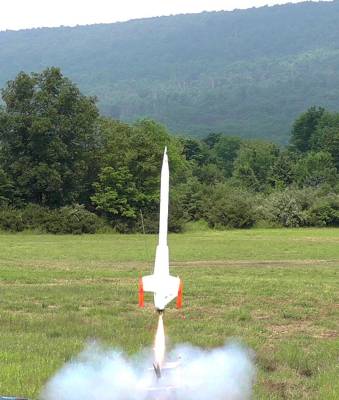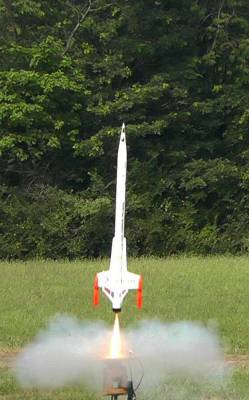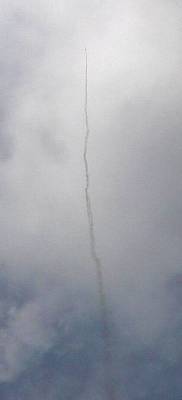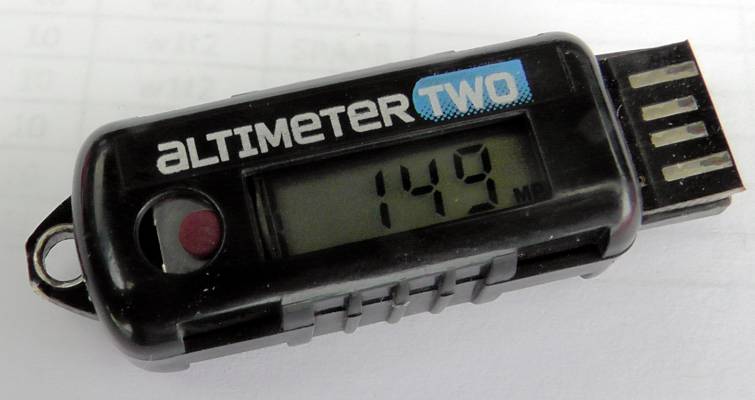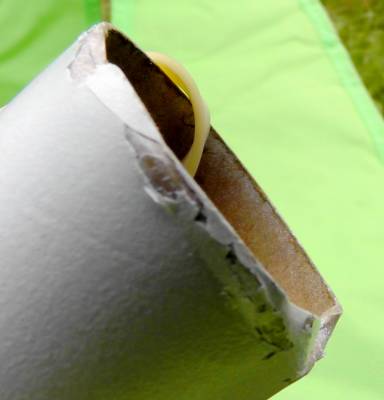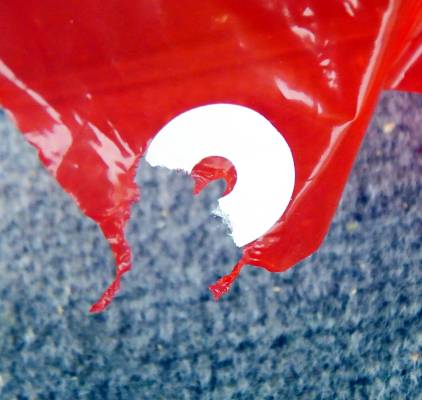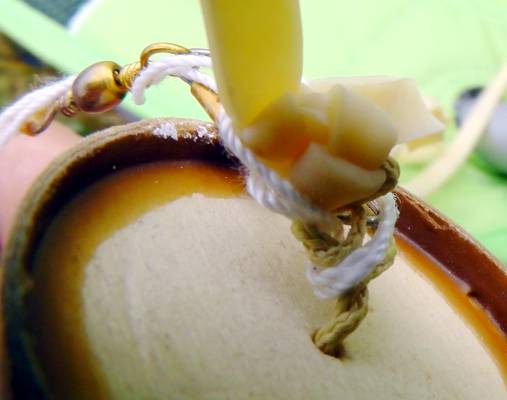The Interceptor: This rocket kit is the new release of the Estes Interceptor. It flies on 18mm B and C motors. This kit was modified with an ejection-gas baffle and Kevlar shock cord mount, and an Iris Altimeter Payload Section. After 6 months, it's finally ready. Construction went well, but painting using bargain-price Home Depot paint resulted in "orange peel" finish, which had to be sanded off - TWICE, and re-applied. The paint then reacted with the primer (SAME BRAND!!) and crinkled and cracked the finish. Re-sanded again and then used the expensive but acceptable Testors paint for $5 per 3 oz can. Clear-coat, decals, then 3 more clear-coats and finally it's done. With the generous glue, extra paint and the added electronics bay, she weighs in at 164.5 grams (5.6 oz.) and is 3.2" longer than stock. I'll plan to use the shorter ejection motors than recommended, just in case it's a little too heavy. Typically for me, this model only passed a string-stability test after I added 17 grams of nose-weight on the base of the nosecone. (Am I doing them wrong??) We'll see how well she flies, but she sure is a pretty gal!
We DID see how she flies, and it wasn't pretty. This model is grossly overweight. The baffle (10 grams?), payload section (19 grams), and the heavy nose-weight (17 grams) makes this too much for even a C6-3 motor. I'm going to send this up on a D10 just to see how well she can fly. Then I'm going to have to take out that nose-weight and see if it's stable enough for flight, I expect it to fly better that way. If it does not and it is destroyed, at least I'll have that one good D-flight to remember.
With the Apogee (Aerotek) D10 motor, this model has flown This rocket has flown higher than the St. Louis Gateway Arch, the Singer building in NY, NY, and the Chicago Temple Building.
I won't want to fly this on a regular basis using the $10 apogee motors though, so instead I hatched a plan to add two small A10-3T boosters on the back, for a total impulse with a C6 motor of 26. The parts for the "solid-rocket-boosters" were obtained from two Estes 220 Swift rockets. I'm waiting to see how well it will fly without the nose-weight before proceeding with this plan. It would be my first cluster rocket project.
| Flight Date: | 2013-06-30 |
| Rocket Name: | Interceptor |
| Kit Name: | Estes - Interceptor {Kit} (1250) [2008-2011,2019-] |
| Flyer's Name: | Rich DeAngelis |
| Motors: | D10-5 |
| Expected Altitude: | 750 Feet |
| Wind Speed: | 4.00 mph |
| Launch Site: | Fort Indiantown Gap, PA |
| Actual Altitude: | 761 Feet |
I wanted one more high performance flight for the Interceptor. This was my 200th flight as a BAR, so I loaded it with the Apogee (Aerotech) D10-5 composite propellant motor. With less nose weight, I expected even better speed and altitude performance, and I got it.
I had to remove the label to get the motor to fit. Again the copperhead igniter worked well, and the motor lit up with a roar. This time it accelerated off the pad with 9 Gs of acceleration, and averaged 5.2 Gs for the 1.3 second burn. This was record high acceleration for the Interceptor, and it also hit a record speed of 149 mph, travelling straight up. It then coasted in a gentle arc for the 6.4 seconds to reach an apogee of 761 feet, also a record.
Often the Altimeter 2 does not detect ejection for unknown reasons, and again this time it did not, but it appeared to eject close to apogee, though a little lower at 747 feet. I don’t know if that was before or after apogee. The parachute popped, opened up, and the rocket descended at 8mph for a total flight duration of 1 minute and 6.6 seconds, a record duration for this model, and a record-low descent speed.
Outwardly the flight appeared to be good, but there were problems, a bunch of them actually. One of the thin shroud strings ripped thru the light translucent Estes plastic and the reinforcement ring, making the canopy lopsided. A second shroud line was caught and wrapped around the shock cord’s knot. There was no evidence of burning on the parachute. The combined asymmetry caused rapid rotation of the parachute, and the shock cord (with no swivel) was very severely twisted in knots by the time it hit earth again.
There was still enough parachute to protect the rocket, since it fell at only 8 mph. It landed softly in the grass. Post-flight inspection revealed the upper body tube was crushed in the last ¼ inch or so. It seems to have been caused by the shock cord recoil, since it landed softly on the rear of the rocket.
The hollow cardboard bulkhead is 2 inches in length, one inch covered by the payload tube, and one inch covered by the body tube. After landing, only about ¼ to ½ inch was exposed, the rest of the bulkhead having been pushed into the payload.I don’t understand how that could have happened except for an extremely powerful ejection that forced it upwards into the payload tube. More evidence of the powerful ejection was on the Altimeter Two. The circuit board assembly, including the display and control button, was forced down into the plastic case, or the case was forced up past the circuit board. I’ve seen this before on a hard landing, but never from an ejection.
I have seen these Apogee motors seem to have very intense ejections, so this seems to be expected damage. Even though it has an ejection baffle, I learned to use wadding anyways. While the D10 composite motors are impressive and fun, they are expensive and seem to cause too much ejection problems for these smaller rockets. I could get more power from either a black powder E, or a cluster of Cs which are certainly cheaper. I will not fly this rocket on the D10’s anymore to prevent more damage. Instead, I will go ahead with my plans to add two small “JATO” booster rockets made from a pair of A10-3T motors. Before I do that though, I want to fly one or two more experimental flights but this time removing all the 8 grams of nose weight, and see if the regular C6-3 can fly this well enough.
So my 200th flight appeared to be jinxed. I scrubbed the mission two months ago because flight #199 ended with my Big Bertha in a tree 60 feet up. The next month was cancelled because of high winds (20 gusting to 35). This flight went off today, but there were just so many things going wrong for it that it was lucky I got it back at all!
| Stage | Motor(s) |
|---|---|
| 1 | Aerotech D10W-5 |
Sponsored Ads
 |
 |
